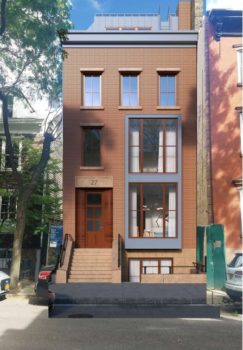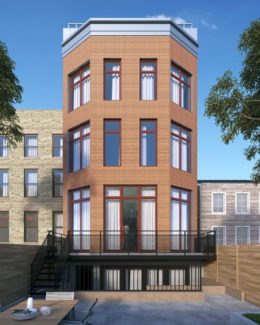
Update Front Rendering of 27 Cranberry Street Image Credit: Landmarks
Formerly approved design seeks re-approval with modifications. On October 8, 2019, the Landmarks Preservation Commission heard an application for a Certificate of Appropriateness, to construct a new three-story, single-family residential building on a vacant lot located at 27 Cranberry Street in Brooklyn. The lot is located on the north side of Cranberry Street, on the middle of the block between Willow Street and Hicks Street. The block consists of primarily three and four-story rowhouses. Directly to the left of the site is a two-story, 200 year old, wooden home. To the right is another three-story rowhouse. The lot is located right in the middle of the Brooklyn Heights Historic District.
The Brooklyn Heights area is an elevated plateau, bounded on the west by the East River and the Fulton Street to the north. The area was originally a Native American settlement and was re-settled in the Dutch Colonial era. The district was historically residential and grew as ferry boats became steam-propelled in the early 19th century. The obvious attraction to Brooklyn Heights was the proximity to lower Manhattan, and with the steam ferries, the suburban commuter class was created. Additions of the Brooklyn Bridge and the Brooklyn-Queens Expressway brought even more commuters to the area. Since the 1950’s Brooklyn Heights has experienced a renaissance with new investment and young-couples moving into the area to restore houses. In the district’s Designation Report, a concern was raised about the district’s “steady deterioration of its historic character”. The concerns specifically included structures which do not conform to the height or quality of the surrounding architecture and defacement of houses through badly planned alterations. Alterations that are incompatible with surrounding architecture. The style of homes currently in the Brooklyn Heights Historic District include Greek Revival, Gothic Revival, Victorian Gothic, Renaissance Revival, Queen Anne, Colonial Revival and hybrids that have no official name. Building heights generally vary between two to five-stories.
This proposal was originally approved August 2, 2011. Modifications were later made to the rooftop penthouse on October 20, 2015 and that approval expired on August 2, 2017. See Cityland’s 2011 coverage here.
Brooklyn Community Board 2 recommended approval of the design but asked that the west façade windows be limited to what was approved in 2011.
The applicants purport that the current proposed design, is essentially the same design approved by the Commission in 2011. The cornice on the front façade which originally featured brackets and coffers now has a more square design that protrudes no further than the prior. The single mantle at the front façade was originally brownstone, but is now proposed as cast-stone to match the remainder of the façade. The new design includes additional windows and shifts the location of the existing lot line windows on the west façade. The window alterations are in response to interior changes. The rear façade was originally proposed as concrete, but is now proposed as brick to match the side façade. The applicant states to have made no changes to the rooftop penthouse, (October 2015 approved modification), other than adding a railing and ladder. The applicant also asks for approval for additional excavation, to add a window to the building’s sub-cellar level. All other excavation is complete.

Updated Rear Rendering of 27 Cranberry Street Image Credit: Landmarks
At the public hearing, members of the community voiced that the design presented was not the same as the formerly approved drawings. Neighbors raised objections that the design was too large and not in character with the neighborhood.
Judy Stanton from the Brooklyn Heights Association said “We have serious objections about this houses as it is presented today. The design overreaches in size and scale. It is out of context to the block…we think the best course of action for the commission to take today is to send the project back to the drawing board.”
Brittany Thomas from the Historic District’s Council stated “We would be more supportive of this proposal if not for the top floor, whose bulk and massing would appear to call attention to an otherwise subdued design.”
The commission was generally concerned with the context of the development. Commissioner John Gustafsson stated that the commission has an obligation to “start from square one, even if the application was approved by a previous commission.” In that context, he pointed out that the commission did not have all the materials they needed to have in order to determine if the height and bulk were appropriate. The rest of the Commission appeared to be in agreement. Ultimately, the Commission ordered the applicants to come back with a presentation that allows for a broader understanding of the block, especially as it pertains comes to the rear portion of the design.
By: Jason Rogovich (Jason Rogovich is the CityLaw Fellow and New York Law School Graduate, Class of 2019)


Great article, Jason!